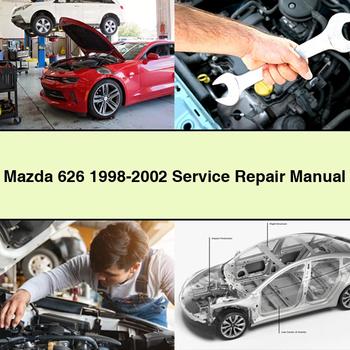This comprehensive Mazda 626 service repair manual covers models from 1998 to 2002, providing detailed instructions and illustrations to help you service and repair your vehicle. It's designed for both experienced mechanics and do-it-yourselfers, offering the same level of information used by Mazda dealerships. The manual guides you through each repair procedure step-by-step, with hundreds of photos and illustrations for clarity.
Detailed substeps expand on repair procedure information, and notes, cautions, and warnings throughout each chapter highlight critical information. Numbered instructions guide you through every repair procedure, while bold figure numbers help you quickly match illustrations with instructions. Enlarged insets allow you to identify and examine parts in detail. A numbered table of contents provides easy access to the information you need.
This manual also features comprehensive troubleshooting and electrical service procedures, along with detailed wiring diagrams for ease of use. It covers all aspects of your Mazda 626's maintenance and repair, including:
* **Maintenance:** Routine maintenance procedures, schedules, and specifications.
* **Engine:** Covers engine components, including the cylinder head, valves, pistons, crankshaft, connecting rods, and lubrication system. Explains how to diagnose and repair engine problems.
* **Control System:** Provides information on the engine control unit (ECU), sensors, and actuators.
* **Mechanical:** Covers the transmission, suspension, steering, brakes, and drivetrain.
* **Fuel Service Specifications:** Details fuel system components, including the fuel tank, fuel lines, fuel pump, fuel injectors, and fuel filter. Explains how to diagnose and repair fuel system problems.
* **Emission Control:** Provides information on the emission control system, including the catalytic converter, oxygen sensors, and EGR system.
* **Intake Exhaust Cooling:** Explains how the intake and exhaust systems work and how to diagnose and repair problems.
* **Lube:** Covers lubrication system components, including the oil pan, oil pump, oil filter, and oil lines.
* **Ignition Starting Charging:** Explains how the ignition, starting, and charging systems work.
* **Auto Transmission Clutch:** Covers the automatic transmission and how to diagnose and repair problems.
* **Manual Transmission:** Explains how the manual transmission works and how to diagnose and repair problems.
* **Transfer Propeller Shaft:** Provides information on the transfer case and propeller shaft.
* **Drive Shaft:** Covers the drive shaft and how to diagnose and repair problems.
* **Differential:** Explains how the differential works and how to diagnose and repair problems.
* **Axle Suspension:** Covers the axles, suspension components, and how to diagnose and repair problems.
* **Tire & Wheel:** Provides information on tires, wheels, and how to diagnose and repair problems.
* **Brake Control:** Covers the brake system, including the master cylinder, brake booster, and brake lines.
* **Brake:** Explains how the brakes work and how to diagnose and repair problems.
* **Parking Brake:** Provides information on the parking brake and how to diagnose and repair problems.
* **Steering Column:** Covers the steering column and how to diagnose and repair problems.
* **Power Steering:** Explains how the power steering system works and how to diagnose and repair problems.
* **Air Condition:** Covers the air conditioning system, including the compressor, condenser, evaporator, and refrigerant.
* **Suppl Restraint System:** Provides information on the supplemental restraint system, including the airbags and seatbelt pretensioners.
* **Seat Belt:** Covers the seat belts and how to diagnose and repair problems.
* **Engine Immobilizer:** Explains how the engine immobilizer system works.
* **Cruise Control:** Covers the cruise control system and how to diagnose and repair problems.
* **Wiper & Washer:** Provides information on the windshield wipers and washers.
* **Door Lock:** Covers the door locks and how to diagnose and repair problems.
* **Meter Audio/Visual:** Explains how the instrument cluster works and how to diagnose and repair problems.
* **Horn:** Covers the horn and how to diagnose and repair problems.
* **Windshield/Glass Mirror:** Provides information on the windshield, windows, and mirrors.
* **Instrument Panel:** Covers the instrument panel and how to diagnose and repair problems.
* **Seat:** Covers the seats and how to diagnose and repair problems.
* **Engine Hood/ Door:** Provides information on the engine hood and doors.
* **Exterior & Interior:** Covers the exterior and interior of the vehicle, including the body panels, trim, and upholstery.
* **Electrical:** Covers the electrical system, including the wiring, fuse box, and battery.
* **Multiplex/ Can Communication:** Explains how the multiplexing and CAN communication systems work.
This comprehensive manual provides all the information you need to keep your Mazda 626 running smoothly.
The Mazda 626, a mid-size sedan, was produced by the Japanese automaker Mazda from 1970 to 2002. The 1998-2002 model years represent the fifth generation of the 626, marking a significant shift in design and technology. This generation introduced a sleek, modern aesthetic with a more rounded exterior compared to its predecessors. While the 626 was initially marketed as a compact car, its size and features positioned it comfortably within the mid-size segment by this era. The 1998-2002 626 was available in several trim levels, providing a range of options to suit diverse needs and budgets. Notable features included a comfortable, well-appointed interior with ample passenger space, advanced safety features for the time, and a variety of engine choices. In the US market, these engines ranged from a 2.0-liter four-cylinder to a 2.5-liter V6, offering a balance of power and fuel efficiency.
The 1998-2002 Mazda 626 proved popular with drivers seeking a reliable and stylish sedan. Its combination of comfort, practicality, and performance contributed to its success. However, like all vehicles, the 626 required routine maintenance and occasional repairs. To ensure reliable operation and prolong the vehicle's lifespan, owners relied on a comprehensive service repair manual. This manual, specifically tailored to the 1998-2002 model years, provided detailed instructions for diagnosing and addressing common issues. It included step-by-step guidance for routine maintenance tasks such as oil changes, filter replacements, and brake inspections. Additionally, the manual offered technical specifications, wiring diagrams, and troubleshooting tips for more complex repairs. By equipping owners with this knowledge and practical information, the service repair manual empowered them to maintain their Mazda 626 effectively and ensure its continued performance.
